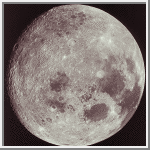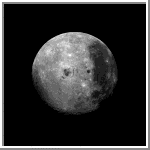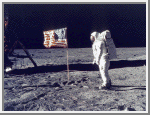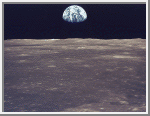 The Moon
The Moon
I had the ambition to not only go farther than man had gone before, but to go as far as it was possible to go.Captain Cook

Lunar Resources on the World-Wide Web

Moon Introduction
The Moon has fascinated Mankind throughout the ages. With the naked eye, one can discern two major types of terrain: relatively bright highlands and darker plains. By the middle of the 17th century, Galileo and other early astronomers had made telescopic observations, noting an almost endless number of overlapping craters.Although a certain amount of information was ascertained about the Moon before the space age, the new era has revealed many secrets barely imaginable before our time. Current knowledge of the Moon is greater than for any other solar system object except the Earth. This gives us a greater understanding of geologic processes and further appreciation of the complexity of terrestrial planets.
On July 20, 1969, Neil Armstrong became the first man to step onto the surface of the Moon. He was followed by Edwin Aldrin, also of the Apollo 11 mission. They and other moon walkers experienced the effects of no atmosphere. Radio communications were used because sound waves can only be heard by travelling through the medium of air. The lunar sky is always black because a blue sky requires an atmosphere. The astronauts also experienced gravitational differences. The moon's gravity is one-sixth that of the Earth's; a man who weighs 82 kilograms (180 pounds) on Earth weighs only 14 kilograms (30 pounds) on the Moon.
Four nuclear-powered seismic stations were installed during the Apollo project to collect seismic data about the interior of the Moon. There is only residual tectonic activity due to cooling and tidal forcing, but other moonquakes have been caused by meteor impacts and artificial means, such as deliberately crashing the Lunar Module into the moon. The results have shown the Moon to have a crust 60 kilometers (37 miles) thick at the center of the near side. If this crust is uniform over the Moon, it would constitute about 10% of the Moon's volume. By comparison, the Earth's crust occupies only 1% of its volume. The seismic determinations of a crust and mantle on the Moon indicate a layered planet with differentiation by igneous processes. There is no evidence for an iron-rich core like the Earth's unless it is a small one. Seismic information has influenced theories about the formation and evolution of the Moon.
The Moon was heavily bombarded early in its history, which caused many of the original rocks of the ancient crust to be thoroughly mixed, melted, buried, or obliterated. Meteorite impacts brought a variety of "exotic" rocks to the Moon so that samples obtained from only 9 locations produced many different rock types for study. The impacts also exposed Moon rocks of great depth and distributed their fragments laterally away from their places of origin, making them more accessible. The underlying crust was also thinned and cracked, allowing molten basalt from the interior to reach the surface. Because the Moon has neither an atmosphere nor any water, the components in the soils do not weather chemically as they would on Earth. Rocks more than 4 billion years old still exist there, yielding information about the early history of the solar system that is unavailable on Earth. Geological activity on the Moon consists of occasional large impacts and the continued formation of the regolith. It is thus considered geologically dead. With such an active early history of bombardment and a relatively abrupt end of heavy impact activity, the Moon is considered fossilized in time.
The Apollo and Luna missions returned 382 kilograms (840 pounds) of rock and soil from the Moon, and three major surface materials have been studied: the regolith (or lunar soil), the maria, and the terrae.
Micrometeorite bombardment is responsible for thoroughly pulverizing the surface rocks into a fine-grained debris, creating the regolith or lunar soil. The soil is unconsolidated mineral grains, rock fragments, and combinations of these which have been welded by impact-generated glass. It is found over the entire Moon, with the exception of steep crater and valley walls. It is 2 to 8 meters (7 to 26 feet) thick on the maria and may exceed 15 meters (49 feet) on the terrae, depending on how long the bedrock underneath it has been exposed to meteoritic bombardment.
The dark, relatively lightly cratered maria (or "oceans", as Galileo thought they might be) cover about 16% of the lunar surface and are concentrated on the nearside of the Moon, mostly within impact basins. This concentration may be explained by the fact that the Moon's center of mass is offset from its geometric center by about 2 kilometers (1.2 miles) in the direction of Earth. It is possible, therefore, that basalt magmas rising from the interior reached the surface easily on the nearside, where the crust is thinner, but encountered difficulty on the farside. Mare rocks are basalt and most date from 3.8 to 3.1 billion years. Some fragments in the highlands date to 4.3 billion years and high-resolution photographs suggest some mare flows may be as young as 1 billion years. The maria average only a few hundred meters in thickness but are so massive they frequently deform the crust underneath them, creating fault-like depressions and raised ridges.
The relatively bright, heavily cratered highlands are called terrae. The craters and basins in the highlands are formed by meteorite impact and are thus older than the maria, having accumulated more craters. The dominant rock types in this region contain high contents of plagioclase feldspar (a mineral rich in calcium and aluminum) and are a mixture of crustal fragments brecciated by meteorite impacts. Most terrae breccias are composed of still older breccia fragments. Other terrae samples are fine-grained crystalline rocks formed by shock melting due to the high pressures of an impact event. Nearly all of the highland breccias and impact melts formed about 4.0 to 3.8 billion years ago. The intense bombardment began 4.6 billion years ago, which is the estimated time of the Moon's origin.

Moon Statistics
Mass ........................................... 7.349 X 1022 kg Mass (Earth = 1) ..................................... 0.0123 Equatorial radius ................................... 1,737.4 km Equatorial radius (Earth = 1) ........................ 0.2724 Mean density ........................................... 3.34 gm/cm3 Mean distance from Earth ............................ 384,400 km Rotational period ..................................... 27.32 days Orbital period ........................................ 27.32 days Mean orbital velocity ................................. 1,030 m/s Orbital eccentricity ................................... 0.05 Tilt of axis ........................................... 6.68° Orbital inclination ............................... 18.3-28.6° Equatorial surface gravity ............................. 1.62 m/s2 Equatorial escape velocity ............................. 2.38 km/s Visual geometric albedo ................................ 0.12 Mean surface temperature (day) .......................... 107 °C Mean surface temperature (night) ....................... -153 °C Maximum surface temperature ............................. 123 °C Minimum surface temperature ............................ -233 °C

Views of the Moon

Apollo 17 - Moon View (Click image to enlarge)
This full disc of the Moon was photographed by the Apollo 17 crew during their trans-Earth coast homeward following a successful lunar landing mission in December 1972. Mare seen on this photo include Serentatis, Tranquillitatis, Nectaris, Foecunditatis and Crisium.
(Courtesy NASA)

Far Side of the Moon (Click image to enlarge)
I'm not quite sure of the origin of this image; I believe it was made by Soviet Lunar Orbiter satellites in the 1970's.

Apollo 11 - Flying Flag (Click image to enlarge)
Astronaut Edwin E. Aldrin, lunar module pilot, poses for a photograph beside the deployed United States flag during Apollo 11 extravehicular activity on the lunar surface. The Lunar Module Eagle is on the left. The footprints of the astronauts are clearly visible in the soil of the Moon. This picture was taken by Astronaut Neil A. Armstrong, commander, with a 70mm lunar surface camera. (Courtesy NASA)

Apollo 11 - Earth as seen from the Moon (Click image to enlarge)
This view of the Earth rising over the Moon's horizon was taken from the Apollo 11 spacecraft. The lunar terrain pictured is in the area of Smyth's Sea on the nearside. (Courtesy NASA)

Apollo 15 - Lunar Roving Vehicle (Click image to enlarge)
This is a view of the Lunar Roving Vehicle photographed against the desolate lunar landscape during an Apollo 15 extravehicular activity (EVA) at the Hadley-Apennine landing site. This view is looking north. The west edge of Mount Hadley, which rises 4,500 meters (14,800 feet) above the plain, is at the upper right edge of the picture. The most distant lunar feature visible is approximately 25 kilometers (16 miles) away. (Courtesy NASA)
This page is adopted from the World-Wide Web Site "The Moon" by Rosanna L. and Calvin J. Hamilton. Copyright © 1996